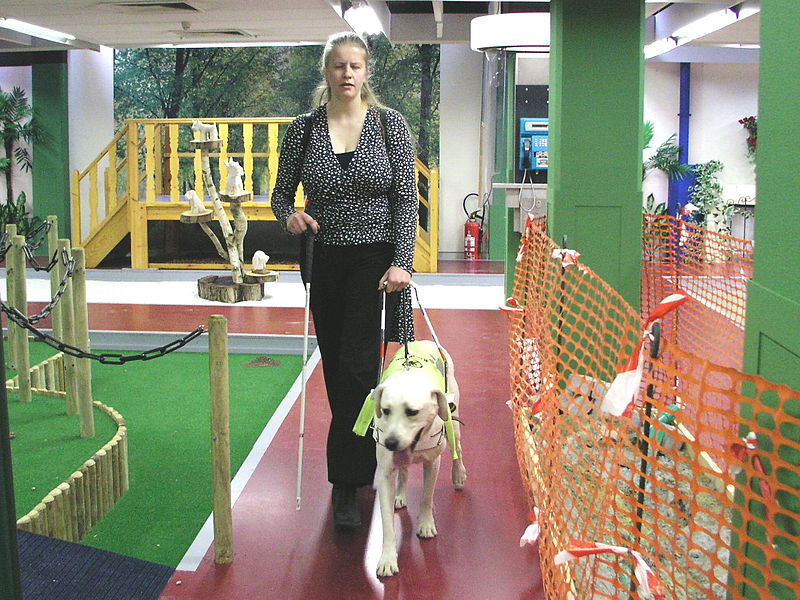| 排名 | 部门名称 | 信息量 |
| 1 | 政治处 | 54 |
| 2 | 办公室 | 42 |
| 3 | 繁育研究室 | 35 |
| 4 | 科研管理处 | 22 |
| 5 | 装财处 | 12 |
| 6 | 警犬技术教研室 | 10 |
How do you train a guide dog
发布人:张跃骏 | 转贴自:本站原创 | 更新时间:2012/8/10 | 阅读:21821

The first part of guide dog training is usually done by puppy raisers who socialize and habituate pups in their care and teach them basic manners and obedience under the supervision of a trainer from a guide dog school. This process typically takes 12 to 18 months. At the end of that time, guide dog candidates are returned to their schools for advanced training in obstacle avoidance, directed guiding, and intelligent disobedience.
Directed guiding ("left," "right," "forward," "wait") is taught by pairing the commands with the actions. It's the easiest part of the advanced training, but also the most used.
Intelligent disobedience is the process of recognizing when there is an exception to a command and disobeying out of duty rather than disobeying because the dog would rather do something else. For example, if a guide dog is given a command to "forward" into a street, but he sees a car coming, he will intelligently disobey the command to "forward" because it is dangerous to the handler to step in front of a moving car.
Obstacle avoidance is the most important safety skill of guide dogs and the one that most fascinates people curious about guide dogs. Once an obstacle is recognized, the dog is instructed to navigate around that obstacle. He must do so regardless of whether the best path lies to the right or left of the obstacle, and while taking into account not only his own path, but the path of his human partner. Guide dogs are also trained to recognize low hanging obstacles, such as tree branches, that could injure their partner and to navigate around them as well.
Here's one example of how obstacle avoidance might be taught:
Avoiding low hanging tree branches
The trainer approaches a low hanging tree branch with a cane held in front of her face. When the cane hits the tree branch it makes an audible cue to the dog that something has happened. The trainer might also say "ouch" or otherwise indicate an injury has occurred (good acting on the trainer's part is essential for this to work). The team will repeat this exercise with the same tree a few times until the dog is consistently navigating around the branch. Then the trainer finds another branch in another area for additional practice. Because dogs don't generalize well, it is important to practice the same concept (avoid low hanging branches) in several different locations and situations until the dog realizes all low branches and not just specific ones are to be avoided.
Read more: http://wiki.answers.com/Q/How_do_you_train_a_guide_dog#ixzz1yEEqNc4S
Directed guiding ("left," "right," "forward," "wait") is taught by pairing the commands with the actions. It's the easiest part of the advanced training, but also the most used.
Intelligent disobedience is the process of recognizing when there is an exception to a command and disobeying out of duty rather than disobeying because the dog would rather do something else. For example, if a guide dog is given a command to "forward" into a street, but he sees a car coming, he will intelligently disobey the command to "forward" because it is dangerous to the handler to step in front of a moving car.
Obstacle avoidance is the most important safety skill of guide dogs and the one that most fascinates people curious about guide dogs. Once an obstacle is recognized, the dog is instructed to navigate around that obstacle. He must do so regardless of whether the best path lies to the right or left of the obstacle, and while taking into account not only his own path, but the path of his human partner. Guide dogs are also trained to recognize low hanging obstacles, such as tree branches, that could injure their partner and to navigate around them as well.
Here's one example of how obstacle avoidance might be taught:
Avoiding low hanging tree branches
The trainer approaches a low hanging tree branch with a cane held in front of her face. When the cane hits the tree branch it makes an audible cue to the dog that something has happened. The trainer might also say "ouch" or otherwise indicate an injury has occurred (good acting on the trainer's part is essential for this to work). The team will repeat this exercise with the same tree a few times until the dog is consistently navigating around the branch. Then the trainer finds another branch in another area for additional practice. Because dogs don't generalize well, it is important to practice the same concept (avoid low hanging branches) in several different locations and situations until the dog realizes all low branches and not just specific ones are to be avoided.
Read more: http://wiki.answers.com/Q/How_do_you_train_a_guide_dog#ixzz1yEEqNc4S
[1]

